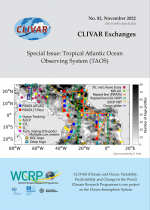The CLIVAR Science Steering Committee (SSG) coordinated the co-chairs of its panels and research foci to produce a white paper for OceanObs’19 entitled ‘Ocean Climate Observing Requirements in Support of Climate Research and Climate Information’, that has recently been published in Frontiers in Marine Science.
Science Highlights
Please have a look at the Guidelines for Science Highlights
The major scientific and observational progress of the last decade and an assessment of key priorities for the coming decade with the goal of achieving the SOOS vision and delivering essential data to all end-users were presented in the paper jointly contributed by SOOS and SORP, in addition with other authors.
Because of the existing confusion about multiple perspectives on high-end scenarios, there needs to be a reconciliation of those perspectives by integrating the best scientific information and guidance to provide consensus on actionable science.
An article on 'A Sustained Ocean Observing System in the Indian Ocean for Climate Related Scientific Knowledge and Societal Needs' has recently been published on Frontiers in Marine Science, as one of the contribution to the 'OceanObs'19: An Ocean of Opportunity'.
Members from the CLIVAR Ocean Model Development Panel (OMDP) and collaborators summarized the new developments in ocean modeling since a similar OMDP review from 2010.
The El Niño-Southern Oscillation (ENSO) affects the rest of the world’s tropics by perturbing global atmosphere circulation, inducing anomalous Sea surface temperatures over the tropical Indian Ocean and Atlantic Ocean. The associated wind variations in the Indian Ocean and in the equatorial and north tropical Atlantic in turn contribute to ENSO dynamics. In addition, the tropical interbasin linkages vary on decadal time scales.
The scientific challenge is extreme due to the rich complexity of interactions and feedbacks between regional and global processes, each of which affects the global climate trajectory. Technical development, international coordination, and a close interaction between the science and stakeholder communities are also required.
The El Niño-Southern Oscillation (ENSO) is the most consequential climate phenomenon on Earth. However, a lack of inter-model consensus regarding the response of eastern Pacific sea surface temperatures means that the effect of global warming on the ENSO remains uncertain for decades.
The complicated communications between the BOB and the equatorial Indian Ocean through both ocean and atmospheric teleconnections are one of the most important aspects of the tropical Indian Ocean climate. By analyzing satellite observational data and ocean general circulation model experiments, this study investigates the key processes that determine the spatial distribution and seasonality of intraseasonal eddy kinetic energy (EKE) within the Bay of Bengal (BOB).
Figure: Changes in Southern Ocean temperature (left) and salinity (right) over 1950 to 2015 in observations (a, b) and CanESM2 sub-sampled to the observed coverage (c, d), and CanESM2 with full coverage (e, f).
Figure: Coefficient of variability (relative magnitude of the standard deviation to the average value) of SST and OMT during 1993–2017 (Courtesy: SCIENTIFIC REPORTS | (2018) 8:12092 | DOI:10.1038/s41598-018-30552-0).
The Early Career Scientists Symposium was held alongside the 2016 CLIVAR Open Science Conference in Qingdao, hosted by the First Institute of Oceanography. The Symposium aimed to capture the ideas of early career researchers on pressing science priorities, immediate challenges, and emerging opportunities to help guide the future evolution of CLIVAR.
Dynamical processes in the atmosphere and ocean are central to determining the large-scale drivers of regional climate change, yet their predictive understanding is poor.
Under the 2015 Paris Agreement, nations agreed to limit global mean warming to 2°C, while also working toward the more ambitious goal of limiting warming to 1.5°C. However, current pledges to support the Paris Agreement would only limit global warming to 3°C. Would meeting the Paris temperature goals be sufficient to avoid an ice-free Arctic?
Meeting report of the International WCRP/IOC Conference on Regional Sea Level Rise and Its Impacts has been published in EOS on 05 January 2018.

























